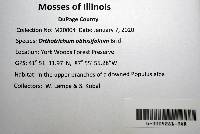
Consortium of Bryophyte Herbaria
- building a Consortium of Bryophytes and Lichens as keystones of cryptobiotic communities -
|
|
|
|
Family: Orthotrichaceae
obtuseleaf aspen moss
[Dorcadion obtusifolium (Brid.) Lindb., more] |
|
Powered by Symbiota.


































































































